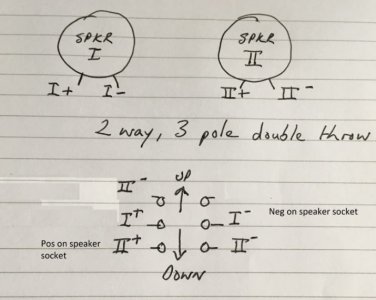Hi,
I have a 2 x 12 speaker cab that is 16 ohms. It is two 8 ohm speakers in series. I use it with an Engl Ironball that has a 16 ohm output.
I also want to use the cab with an amp that only has 4 and 8 ohm outputs. Putting the two 8 ohms in parallel will give me 4 ohms.
So, I can re-wire for impedence matching for either amp, but not both.
I've tried to sketch out the wiring for a switch to flip from one mode to the other.....can anyone confirm if this is correct? And does it matter whether the tip or ring of the speaker cable goes to positive on the speaker?

Thanks,
Andy
I have a 2 x 12 speaker cab that is 16 ohms. It is two 8 ohm speakers in series. I use it with an Engl Ironball that has a 16 ohm output.
I also want to use the cab with an amp that only has 4 and 8 ohm outputs. Putting the two 8 ohms in parallel will give me 4 ohms.
So, I can re-wire for impedence matching for either amp, but not both.
I've tried to sketch out the wiring for a switch to flip from one mode to the other.....can anyone confirm if this is correct? And does it matter whether the tip or ring of the speaker cable goes to positive on the speaker?

Thanks,
Andy


